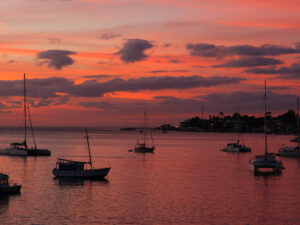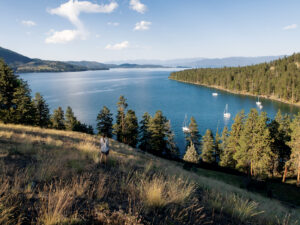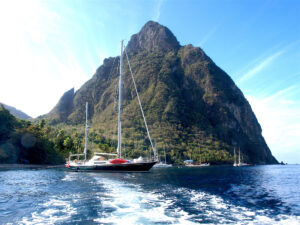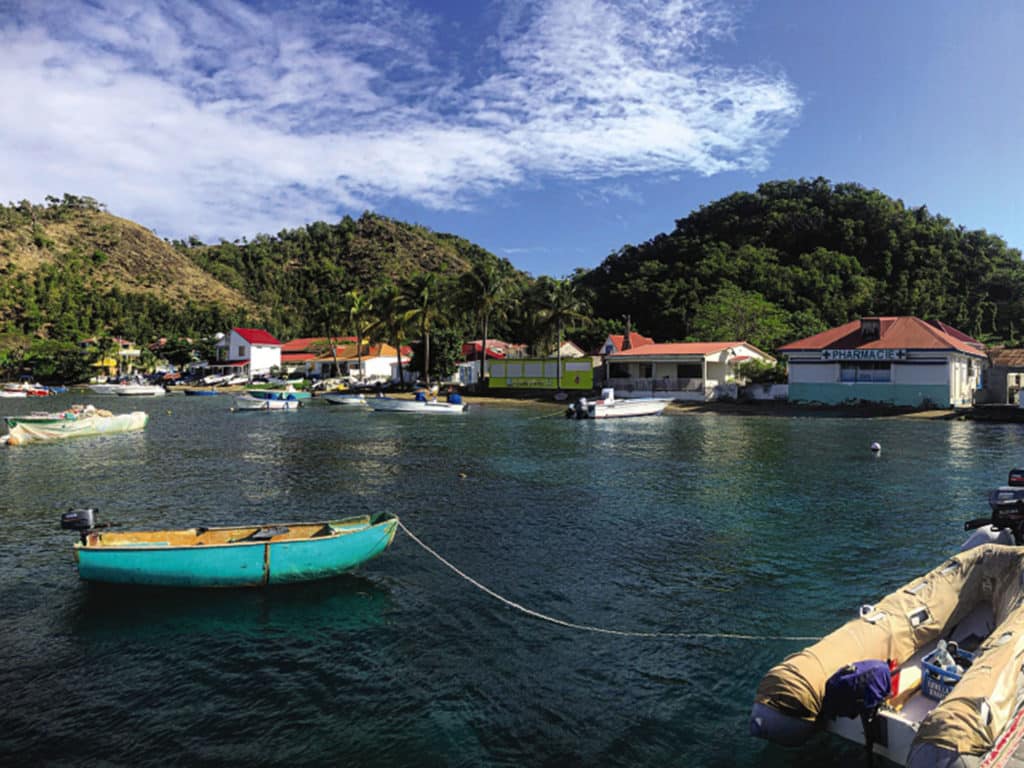
The boat lurched from side to side and our dinner plates slid from the shelves, causing them to crash to the floor. In the moon’s absence, the water was ink-black. Foreboding rocky cliffs were to starboard, appearing closer than they actually were. Having sailed 72 nautical miles from Martinique in salty conditions, my husband, Dave, our three boys and I were feeling weary and decided to put up with the uncomfortable anchorage until morning. Sleep came in fits and bursts; sunrise brought little respite from the relentless roll. Feeling more seasick at anchor than we did on passage, we made the wet dinghy ride to shore for some reprieve. We looked back in awe as Roam, our Moody 47, rolled back and forth in the swell, the rails not far from the water. The moment we reached the lee of the headland, the water smoothed, and we could finally relax. Questioning the local authorities’ motives behind why we were not allowed to anchor any closer to shore, we vowed to spend 13 euros on a mooring ball the moment one became available. For now, though, we were in desperate need of coffee and somewhere still, to sit and enjoy it.
Despite the uncomfortable start, the Caribbean island of Terre-de-Haut—known for its coral-rich waters and palm-tree-lined beaches—instantly charmed us, and our sleepless night was quickly forgotten. Located only 6 nautical miles from the southernmost tip of Guadeloupe, Îles des Saintes—or Les Saintes, as it’s more casually known—is made up of nine idyllic islands, of which only two are inhabited. The island group is renowned for the clarity of its waters; orange starfish could be seen resting on the seabed from many meters above. The horseshoe-shaped bay, dotted with colorful fishing boats dancing quietly on anchor, provided shelter for a field of some 80 mooring balls. The anchorage was located farther behind, marked by a row of yellow buoys. Small gray pelicans darted and weaved among the boats, searching for fish.
Ashore, gingerbread-house-like cottages complete with latticework and window shutters lined the waterfront. Their matching roofs provided the feel of a Greek island, despite their rust-red color. The smell of freshly baked baguettes and coffee wafted from the tiny waterfront cafes, and from the moment we secured our dinghy to the dock, we were captivated by the attractive village of Bourg des Saintes. Patterned sarongs and flowing silk dresses could be seen blowing gracefully in the breeze from the open windows of boutiques lining the narrow streets. We were excited to discover what this island, with its bustling shopfronts and whitewashed cottages, had to offer.
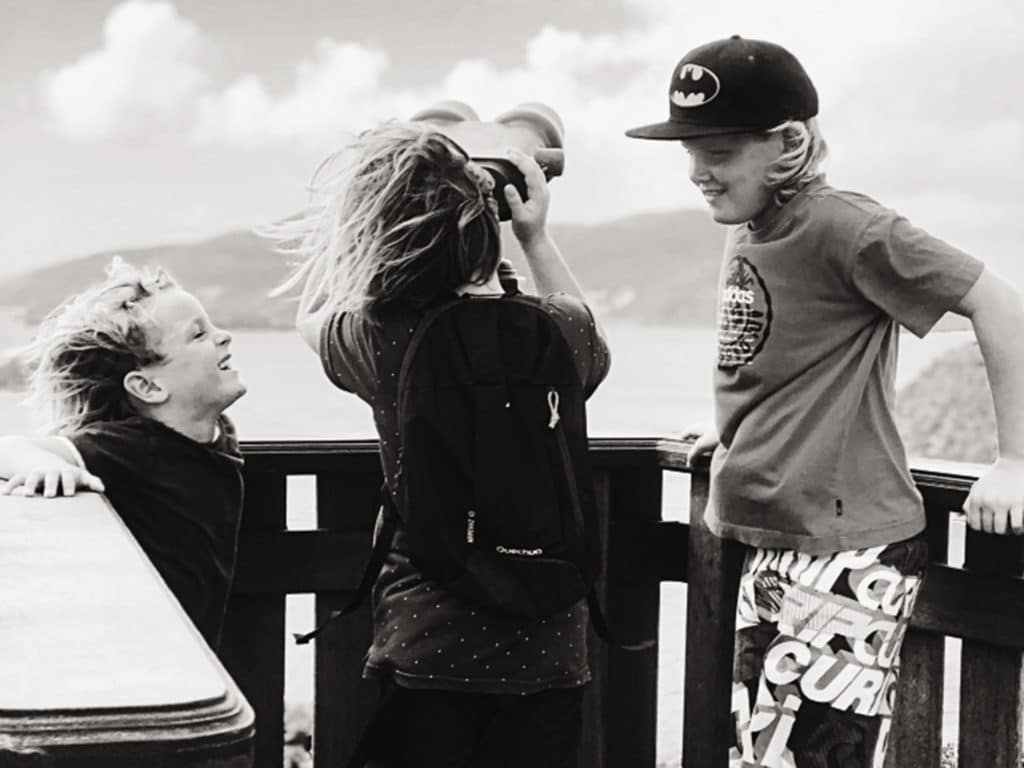
Although it was the middle of winter, the sun was warm and the sky clear. After a breakfast of croissants and coffee (after all, the islands of Les Saintes are French), we began wandering around the small village. The first thing we noticed was the absence of cars. Instead, tourists and locals alike were scooting along on electric golf carts and mopeds. Being on a modest cruisers’ budget, we skipped a rental and continued on foot. As we made our way to the northern end of the island, we passed enchanting cottages and fences covered in pink hibiscus. Hummingbirds flitted from flower to flower, drinking the sweet nectar, and curtains bellowed from kitchen windows, begging us to peer inside. Elderly women strolled the streets, selling French pastries from handmade wicker baskets.
We were curious to sample these round tarts, with their crunchy base and moist center. Filled with coconut, banana or guava jam, and topped with the softest sponge, these delicious delicacies did not disappoint. “Parlez-vous Anglais?” we asked one of the women. Demonstrating her lack of English by holding up her thumb and forefinger to make the symbol known the world over as “a little,” she told us that these tender, pillowlike tarts were called tourment d’amour, meaning “love’s torment.” In broken English that was far better than my French, she told us how the women of Les Saintes would lovingly bake these little delights, waiting anxiously for the return of their husbands from the sea—sadly, a day that for some, would never come. Today, heartbreakingly, the tarts are baked only by widows, perhaps the most sorrowful story behind any dessert I have ever tasted.
Having earlier viewed a fort perched high upon a mountaintop, we were curious to discover the history within its walls. The road was steep, but thankfully, the breathtaking view of the bay and nearby Guadeloupe kept us motivated. We watched with envy as golf carts and scooters zipped past effortlessly. Built on a bluff, the fort was originally named Fort Louis. Destroyed by British forces in 1809 and rebuilt in 1867, the fort was later named after Napoleon and never again used in battle. Instead, it was used as a penitentiary, and is currently a museum open to the public. As we wandered through the gardens surrounding the fort, large iguanas could be seen dozing sleepily on warm rocks, enjoying the sun and posing for the tourists’ photographs. The fort’s fascinating history was detailed within its stone walls, with scale models of English and French ships, along with photographs and maps of the island. These displays provided us with an appreciation of this quaint island’s history, culture and environment.
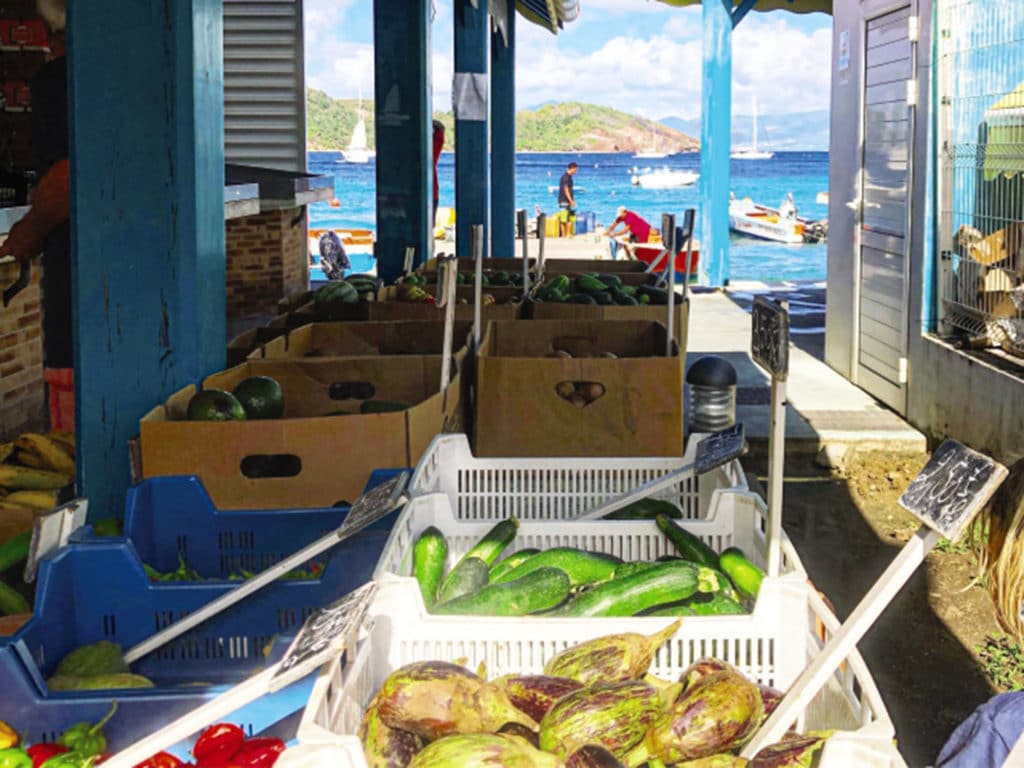
Gorgeous Saintes Bay looked like the kind of image that would be made into a jigsaw puzzle. With our bird’s-eye view over almost the entire island, it was clear to see why the mountainous dry land did not allow the establishment of agriculture. This, in turn, meant that the island was not settled by slaves, unlike most of its neighbors. Since the island has no source of fresh water, the original settlers were not farmers but rather hearty French fishermen who figured out ways to survive when those before them could not. The arid land below was peppered with clusters of tiny cottages among the scrublike landscape, and for a moment, I forgot I was in the Caribbean. Instead, it felt like I was in the Mediterranean, staring out over a Greek or Croatian island.
Making our way back to the village, we decided to stop at a local creperie for lunch. Savoring jambon, fromage and chocolat crepes, we enjoyed the enchanting French conversations that could be heard floating all around us. The island felt European, and its sleepiness during the heat of the day reminded us even more so of our bygone days backpacking around France, Italy and Greece. The many tourists who had arrived by ferry from neighboring islands that morning had dissipated, and the town was now quiet and peaceful.
Following the meandering road out of town, we decided to visit the most popular beach on the island. Pain de Sucre, named after Sugar Loaf Mountain in Rio De Janeiro, was quite a hike and took an hour by foot. The hills were steep, and the hot sun was burning our already tanned skin. With a view over the bay, we spotted Roam floating peacefully below. Snapping a quick photo, we laughed at the fact that a sailor never tires of admiring their boat. The road followed the shoreline, and the red roofs gave way to sapphire-blue water. Goats wandered freely, grazing on the dry grass, and birds could be seen riding thermal currents at eye level.
Soaking in the tranquility of the secluded beach, it was tempting to linger; however, the sun was low in the sky, and the day was drawing to an end.
The miniature beach, found at the bottom of a craggy rock trail, was picture-perfect, and we were desperate to submerge our bodies in the turquoise water. Protected by rocky cliffs on either side, the small bay was lined with coconut palms and fine white sand. Like a scene from a postcard, couples snorkeled in the shallows, likely on their honeymoon. Soaking in the tranquility of the secluded beach, it was tempting to linger; however, the sun was low in the sky, and the day was drawing to an end.
Too exhausted to make the return trek and knowing we wouldn’t arrive before dark, we stuck out our thumbs for a ride. The very first vehicle to approach us stopped. With a quick bonjour, we scrambled into the minivan and wound our way back through the countryside. With a distinct coastal vibe, the town’s main road now bustled with tourists, and the smell of tantalizing seafood filled the air. Spotting a churros vendor, a meager 2 euros had us licking icing sugar from our lips. A sweet ending to a delightful day.
I stole one last view of the harbor as we dinghied back to our boat. Reveling in its beauty and feeling relaxed and content, I wanted to capture the moment on film. The view was even more beautiful than I remembered that morning, yet the lens did not do it justice. With a golden hue now cast over the bay, the water was glistening in the low light, an image I would just have to burn into my memory. A beautiful white boutique hotel sat to the left, and I dreamed of a night between its crisp white sheets. For now, though, I would have to be content with my boat, and I desperately hoped the swell had abated. Typical of the cruising lifestyle, we had experienced both highs and lows in one day. Au revoir, Terre-de-Haut. You were undeniably one of the most charming and idyllic islands we have visited on our journey so far, and one of the Caribbean’s best-kept secrets. Shh, don’t tell anyone!
Hailing from the land Down Under, Erin and her family quit the rat race and moved aboard a vessel they had bought, sight unseen, on the opposite side of the world. Two years earlier, they had come up with the crazy idea after watching a documentary. Roam, their Moody 47, became their ticket to freedom, and carried them safely around the Eastern Caribbean and across the Atlantic Ocean to the Azores, where she sits today, patiently waiting for her next adventure. Follow Erin’s journey on Facebook and Instagram.

